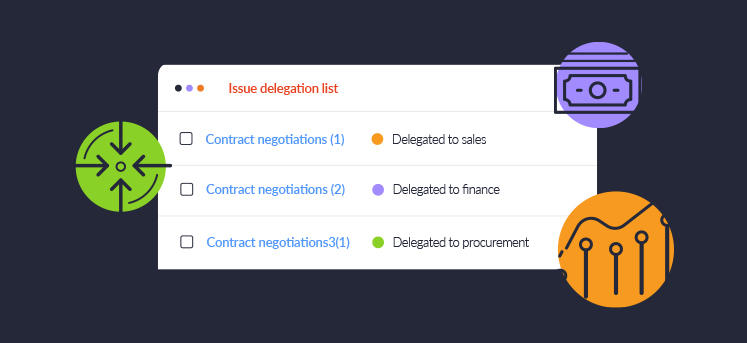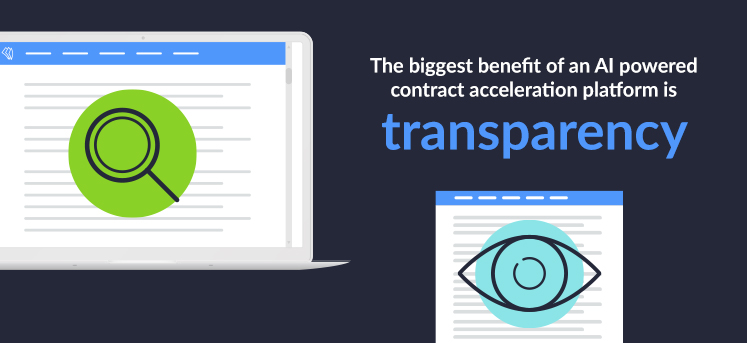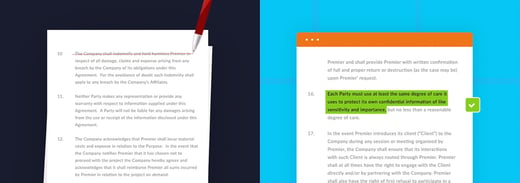How inside counsel can use technology to reduce risk and improve speed.
Negotiating is an art form. Ensuring a smooth process from first draft to signature takes skill and experience. In-house lawyers add significant value to their business through their thorough understanding of the intricate details of contract negotiations.
That said, there’s no reason not to complement that skill with powerful technology to gain an extra edge. Especially if a lawyer lacks experience with specific contracts, the legal team is short on time (which, let’s face it, happens more often than not), or there’s a desire to make contract reviews more consistent across the team.
If you’re looking to enhance or improve contract negotiation within your company, our best practice tips are tailored to ensure your business will benefit from the full value of every contract negotiation.

Start by looking backwards (as well as sidewards)
Racing against the clock and with a mountain of paperwork waiting for your attention, it’s tempting to dive straight in to the next contract review. However, it can be beneficial to look back at similar negotiations before you begin. If properly documented (which admittedly is too rare), you can pick up learnings from what’s already happened.
For a lot of firms, that’s a big if. Experience and knowledge is frequently stored in the GC’s head, or amongst the senior lawyers. Unpicking those nuggets of information is an informal and haphazard process. And if those senior colleagues leave the company, that knowledge goes with them.
Let’s take a closer look at what a best practice approach to contract negotiations looks like.
-
Consult the company playbook
Before you start any new contract negotiation, check out the company risk playbook. What does it say about how to conduct these negotiations and transactions? Which positions are acceptable to the business, and which will raise red flags?
The company playbook is akin to the bible when it comes to contracts so it needs to be regularly reviewed and updated. Whether you’re experienced or new to contract negotiations, consulting the playbook will refresh your knowledge of internal processes and expectations. It will also help establish what’s needed from a new negotiation before any legwork begins.
The key here is accessibility, and how often it is updated. The risk playbook is best digitised, which allows each access and exploration across any number of themes and topics. Knowledge can be accessed with a few clicks of a button. And with each new contract digitised and cross referenced against the risk playbook, it becomes a living breathing document that reflects reality – not a skewed version of what the business thinks it is. -
Has the company negotiated this type of contract previously?
If yes, what can you and the team learn from what went wrong and what really worked? Using previous experiences – good and bad – before starting a new contract will help you establish common causes of delays and what positions will cause the biggest headaches.
In an old-fashioned legal team, this process would be time-consuming and manual. It would either involve searching through boxes of existing paper contracts and cross-referencing clauses, or verbally asking senior lawyers for their input. Both methods have obvious faults. They are both error-prone, with important aspects easily missed or forgotten about. They both take up precious time, which eats away at the contract’s real value. And they are both subjective, with little consistency defining how these processes are followed.
Again, digitised contracts makes this data easily searchable, and actionable. This valuable knowledge is not locked away and unused; it can be used to inform the subsequent contract negotiation. -
Understand the market norm
Once you’ve looked backwards at your company’s historical contracts, it’s time to look out to the wider market. This will answer a number of potential queries and set expectations.
For example, how has market changed since your last contract negotiation? Are your previous positions no longer viable? If so, what are the new market parameters considered normal?
This is particularly useful if negotiations stall over a particular position and neither side is willing to give ground. Referring to market gives both parties an understanding of what is typically agreed in similar negotiations.
The secret here is how to access this data. Word of mouth, personal contacts or individual’s experience are not reliable or objective sources of information. The good news is that contract review platforms can analyse the contents of volumes of contracts, and can use AI to aggregate that data at speed. This means that negotiators using the technology can see how agreements are reached across a wide spectrum of negotiations, which makes it much easier to reach a compromise that both sides consider fair and acceptable.

Create an issues list
While lawyers manage contract negotiations, not every issue is theirs to resolve. An in-house lawyer will delegate issues to sales, procurement, finance… whomever is the best person to advise. For high-value or important contracts, a lawyer will typically create an issues list, detailing what each of the issues is and who owns it.
An issues list enables you to delegate tasks out; hold people accountable for resolving specific issues, while allowing the lawyer to retain overall control of the process. It’s a laborious task, however, and one that the lawyer would more often than not prefer to skip. In reality, issues lists are really only created on the larger and more strategic deals.
Best practice, though, dictates that an issues list should be included in every single deal. And by using the right technology to create and manage that list, lawyers can remove a lot of the pain associated with this.
Creating a digital issues list makes it easy to highlight which issues are the responsibility of delegated individuals. It’s also far simpler to communicate those details to the relevant people charged with finding a solution. Likewise managing that list and keeping it up to date is a standardised, consistent process. As is often the case, relying on manual processes greatly increases the risk of something slipping through the cracks.
By managing an issues list, it demonstrates to stakeholders that issues have been seen and dealt with. It reassures them there’s no further risk in signatories finalising the deal. A fail-safe tactic for getting those trickier negotiations over the line quicker.

Make the process transparent
Using AI technology to drive contract negotiations helps to speed up the more laborious side of sealing the deal. Technology will help your firm in a number of ways, such as by using data to compare similar contracts and improve the efficiency of each new negotiation.
Arguably the biggest benefit of an AI powered contract acceleration platform is transparency. AI will explore previous contracts to surface those that are relevant to the current negotiation. It will provide frames of reference with historical documents. It will capture positions that are at odds with the risk playbook. It can document a comprehensive issues list and make it easy to manage issues as they are ticked off. And it can make it easy for signatories to see that risks have been spotted and mitigated.
Summary
Experience, knowledge, and excellent decision making are the hallmarks of an inside counsel who can add real value to the business. While these qualities are built up through training and years spent in the job, they can also be fast tracked with intelligent contract review technology. With legal technology supporting best practice processes, it’s far easier for an in-house lawyer to apply this methodology to every new contract negotiation.




